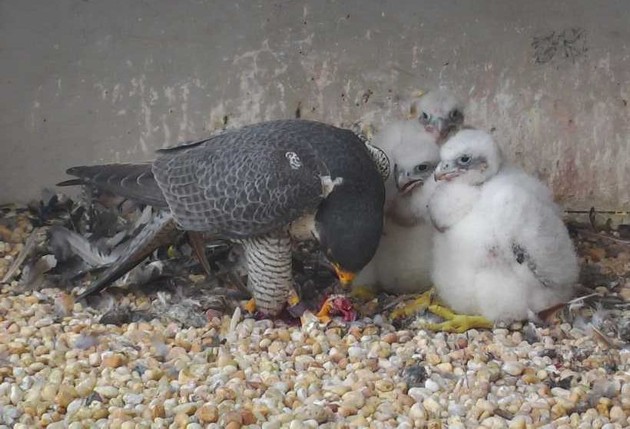
News from Pittsburgh’s two “on camera” peregrine falcon families:
- Dori and Louie + 3 chicks (G1, G2, G3) hatched 19 April at the Gulf Tower,
- Hope and Terzo + 3 chicks (C6, C7, C8) hatched 25 April at the Cathedral of Learning.
The Gulf Tower chicks are three weeks old and growing their juvenile feathers. Because of this they now have “faces” and pin feathers visible on the edge of their wings (above).
Are you worried that the parents aren’t nearby because you can’t see them on camera? In Lori Maggio’s photo (below) Louie and Dori are both looking at the nest on the left but you can’t see them on camera because it’s zoomed in. No matter how widely we zoom the camera view, you’ll never see Dori when she’s perched on top of it.
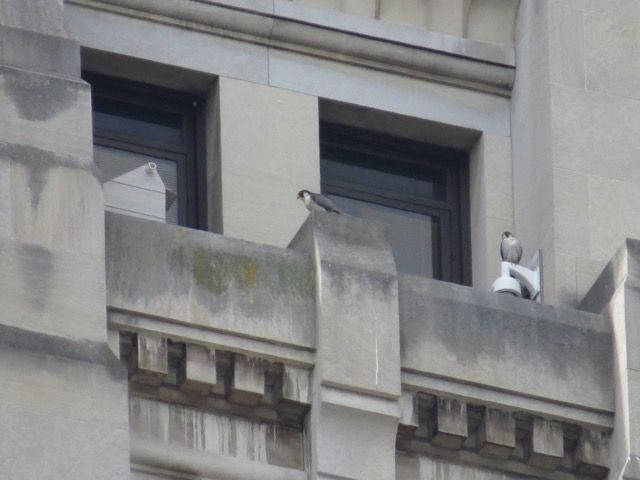
Across town at the Cathedral of Learning the chicks are two weeks old and very well fed. They’re getting feather tracts under their down which makes them look as if they have lines under the white fluff.
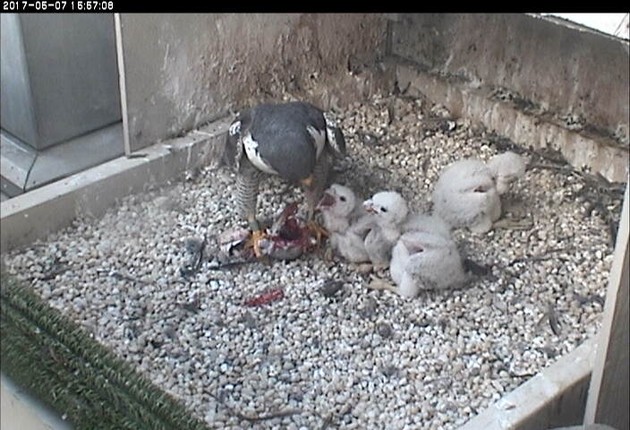
Above, one chick is full so he’s “excused himself from the table.” Later he changes his mind and comes back for more.
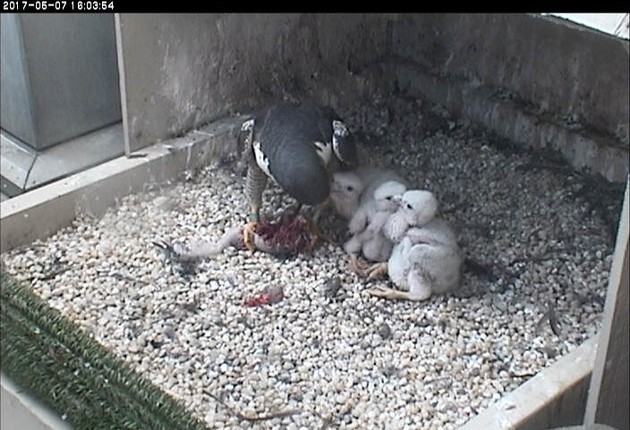
Last weekend a reader asked if Terzo ever comes to the nest. Yes he does. Often. At the end of this feeding, Terzo arrived to shelter the chicks while Hope took out the garbage.
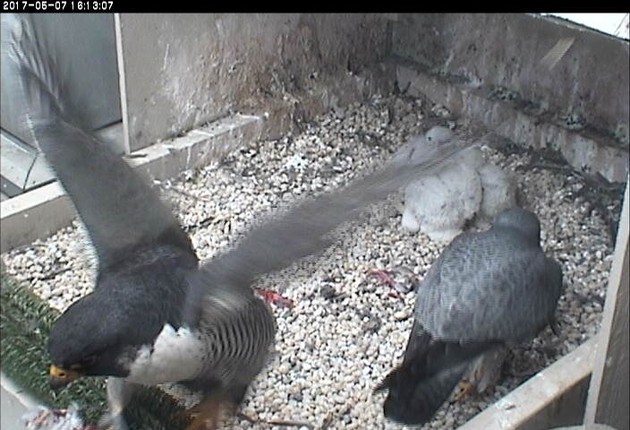
You can tell this is Terzo by looking at the white patch on his face. Terzo’s patch is all white and shaped like a heart. Hope’s is “muddied” by gray at the top of the white.
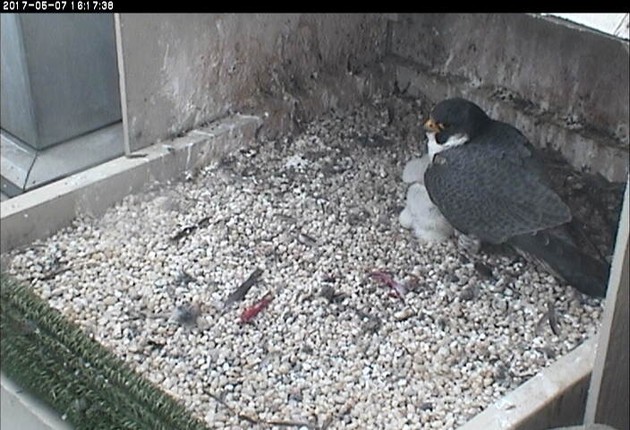
And finally, this Gulf Tower photo can teach us four things about young peregrines.
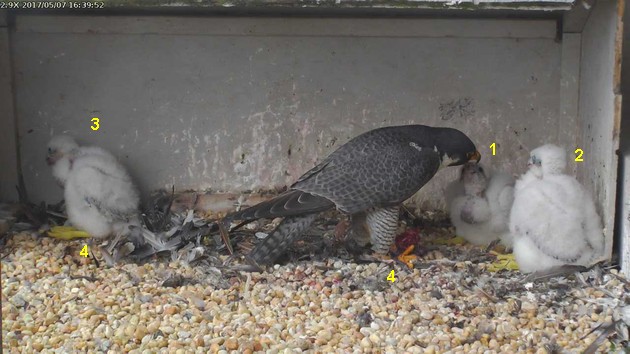
- The chick who is still being fed is nearly full. His crop (in his throat) is bulging so much that it shows bare skin. Later in life his crop will still bulge when he’s full, but it will be covered with feathers.
- Two of the chicks have eaten enough and are no longer hungry. #2 is standing by, posed like a downy Buddha.
- Chick #3 is so full that he’s left for the opposite corner. Yes, the chicks can walk.
- Notice the two #4s by their feet:
- On the left, you see that the chick is resting on his heels rather than standing up on his toes like his mother does. This is normal for his age.
- The chick’s legs and toes are pale yellow. His mother’s are orange-yellow. Immature peregrines retain the pale color until they’re old enough to breed.
(photos from the National Aviary falconcams at the Gulf Tower and Cathedral of Learning)
What a wonderful start to the day. Thanks to Lori for the photo showing the bigger picture, and thanks to you, Kate, for helping us learn more about these magnificent birds through photos and descriptions.
Kate, thanks so much for the update. It is so nice to see everyone being so very well taken care of. They are growing so fast. I’ll miss them when they start to fledge. I still think of C1 and where ever she may be.
It’s turning into such an awesome season! The chicks are adorable mounds of fluff and the parents are all doing great jobs. It is a delight to watch and see. I know we have a few weeks yet, but how fun! 6 fledglings… SIX on camera… I can’t wait.
I’m curious about banding? Dori and Louie’s are much bigger,and almost a week older. Will that impact anything? Will you go on two days or split the difference?
Thanks for blogging and keeping us educated.
Thank you so much for the progress reports about the peregrines. There is so much to learn about their behavior and your descriptions are appreciated !
It’s really great to have two places to watch these beautiful birds this year. They are all doing so well and getting big! Thanks for all the pictures and great facts.
So happy that chicks in both nests are so healthy and are growing quickly. Both sets of parents are keeping their babies full of food and are maintaining watchful eyes over their nests. Looking like a successful year for peregrines in pittsburgh. 4 new chicks at the great spirit bluff location in minnesota. Waiting for chicks to hatch at the lansing michigan eckert power station. Complete change of adults at the nest this year. Mom hit by car last year during fledging and dad lost fight with new male this year.
Why do you think the Gulf nest is so much messier than the Cathedral nest? Is it a housekeeping problem or more related to exposure to wind and weather? They couldn’t be more different even though both have three well-fed chicks. Thanks for all your updates.
Susan, the difference in nest maintenance is just a difference between then two females’ styles.
I kind of like that the two nests look so drastically different – it’s a neat reminder that each of these falcons is an individual. And wow, the Gulf chicks are getting so big – poor ol’ Louie looks smaller every day! 🙂
Kate, You know I have been following you for years. I do not remember reading that they maintain the pale yellow feet until they are ready to mate. I will tell you again that I appreciate that I can count on you to teach me something new almost every day. I am very happy that so far, it is a good year at both sites.
Thanks for the learning experience. I enjoy watching the progress the falcons make on a daily basis. Keep up the good work and know you are appreciated.
I must say that all six chicks are definitely very well fed. It seems everyone I tune in to one of the cams the chicks are either eating or sleeping.
It’s amazing what a difference a week makes! The eaglets at Harmer are getting really big too. They will be fledging next month.
Just checked in on the Gulf chicks and all were standing in a row on their feet just like an adult would. It’s amazing how much they grow and change from day to day.